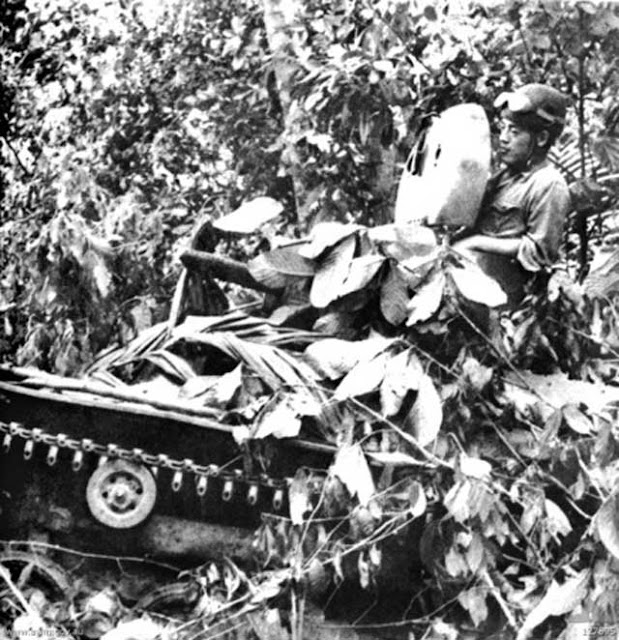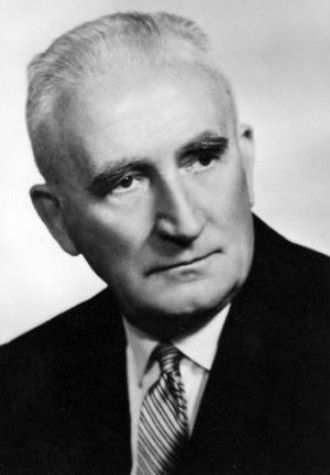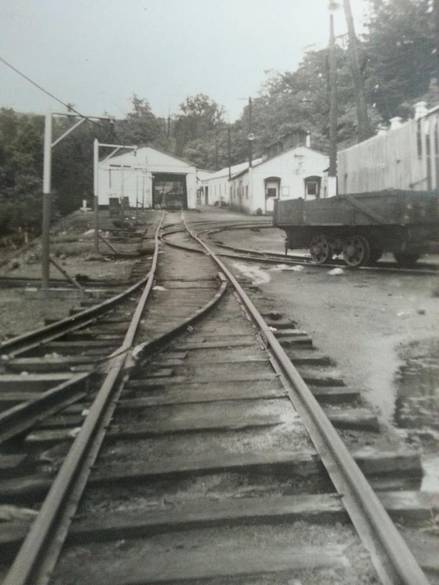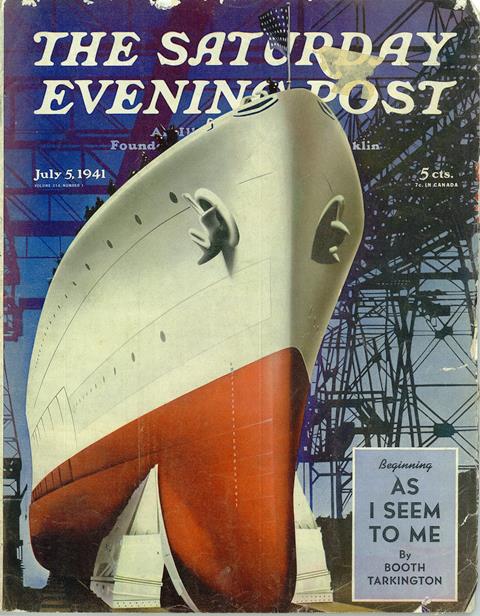Saturday 14 March 1942
 |
| Generalfeldmarschall Keitel, Reichsführer SS Heinrich Himmler, and Generalfeldmarschall Milch waiting for Adolf Hitler in front of the Berlin armory at the 14 March 1942 Heroes Day ceremony. Note that Keitel is holding his Marshal's baton. (Federal Archive Figure 183-J00683). |
Battle of the Pacific: The U.S. Joint Chiefs of Staff has been split between focusing on Japan or Germany as it builds up its forces. On 14 March 1942, it finally decides to lean toward Europe and maintain a more defensive posture in the Pacific Theater of Operations. This decision is strongly opposed by Admiral Ernest J. King, who prefers to focus on the PTO, but he is overruled. Throughout the war, though, King remains a lone voice calling for greater efforts against the Japanese.
During the late morning, coast watchers on the southern shores of New Guinea in the village of Kerema, just west of Port Moresby, spot a large force of Japanese planes heading west. They alert the RAAF by radio. They turn out to be eight Mitsubishi G4M1 heavy bombers escorted by twelve A6M2 Zeros of the 4th Kokutai The Japanese bombers took off from both Rabaul and Lae airfields, are heading toward Australia.
The Japanese bombers raid Horn Island, which is ten miles (16 km) north of Queensland, Australia. They destroy a Hudson bomber and a fuel dump and cause some other damage to infrastructure. The RAAF is able to get fighters in the air due to the warning and shoot down two Mitsubishi A6M Zero fighters (according to the Japanese) or four Zeros and a bomber (according to the Australians). While little noticed by the public, Horn Island is in a critical location in the Torres Strait between Queensland and New Guinea and thus perfectly suited for air operations between Australia and New Guinea. The Allies realize this and are building the island up into the main tactical base for Allied air operations in the Torres Strait. This is the first of nine Japanese air raids against Horn Island.
The first US Army troops land in Australia. General MacArthur, their commander, remains stuck at Del Monte Field on Mindanao in the Philippines awaiting air transport to Darwin.
Eastern Front: It is the second day of the Soviet offensive in the Parpach Narrows, and already it is floundering. The fighting is bitter, but the Germans skillfully protect their strongpoint at Koi-Asan using antitank guns, StuG III tank destroyers, and an increased Luftwaffe presence. The Soviets are launching attack after attack (at least ten in all) with three rifle divisions, but the ground is soggy due to the beginning of the Spring Thaw (Rasputitsa). This slows down the advancing tanks and supporting infantry enough for the Germans to stop them.
The Germans remain determined to begin Operation Raubtier ("Beast of Prey"), the mission to encircle a Soviet salient across the Volkhov River. It already has been delayed for one day due to poor weather. As the new day dawns, however, the temperature has fallen precipitously (-31° F (-35° C). General Küchler, commander of Army Group North, reluctantly postpones the operation for another day. This leaves the infantry, in exposed forward positions ready for the attack, to suffer through another day and night of subzero weather.
European Air Operations: RAF Bomber Command, having conducted major operations against Cologne and scattered other targets during the night of 13/14 March, have a quiet night on the 14th. It sends six Boston bombers on an anti-shipping sweep off Le Havre. This begins a lengthy period in which Bomber Command conducts only small-scale missions as it builds up its strength and waits for good summer weather.
Battle of the Atlantic: After dark, German E-boats attack a British convoy in the North Sea. They sink Royal Navy destroyer HMS Vortigern at a cost of five of their own boats.
Battle of the Mediterranean: U-133 (Kptlt. Eberhard Mohr), on its third patrol but first under new captain Mohr, strikes a mine and sinks two hours south of Salamis. The Salamis wandered off course into a German defensive minefield. All 45 men on board perish. During its career, U-133 sank one ship of 1,920 tons. There is a myth about U-133 that it was on a secret mission to sail up the Colorado River and destroy the Hoover Dam, but that is all it is - a myth.
HMS Ultimatum (P 34, Lt. P.R.H. Harrison, DSC, RN) torpedoes Italian submarine Ammiraglio Millo in the Ionian Sea off Punta (Cape) Stilo, Calabria, Italy. Two out of four torpedoes hit. Commander Harrison takes aboard 14 survivors (57 dead) and then proceeds to Malta.
The German state radio pays the anti-aircraft efforts on Malta a rare compliment, saying:
Partisans: Soviet partisans are becoming a problem for the Germans. They begin to plan operations using military forces to root them out. Today, in anticipation of the first such operation ("Operation Munich") set to begin on 19 March 1942, the Germans set up a special anti-partisan air detachment at Bobruisk.
German/Italian Relations: The two Axis partners sign a new trade agreement.
Anglo/Soviet Relations: The new British Minister to the USSR, Sir Archibald Clark Kerr, arrives in Kuibyshev (Kuybyshev, or Samara). This is the Soviets' alternative capital should Moscow fall and has become a center of the Soviet bureaucracy. Among other things, the Soviets are busy at this time building a secret bunker for Stalin located 37 meters below the CPSU oblast Committee building (later the Samara State University of Culture). Stalin and the military high command (Stavka), however, remain in Moscow and there is no evidence that Stalin ever visits his potential command post in Kuibyshev.
Japanese Military: Now that resistance on Java is over, Japanese Imperial General Headquarters issues orders for "Operation X" (the invasion and occupation of Christmas Island). Rear Admiral Shōji Nishimura is assigned to command the Second Southern Expeditionary Fleet's Occupation Force. The British only have 32 men on Christmas Island. A group of Punjabi troops there recently mutinied and killed five British soldiers, including the British commander, Captain L.W.T. Williams. The invasion is planned for 31 March 1942.
US Military: US Army Air Force units of the 51st Pursuit Group, 10th Air Force, arrive in Karachi, India, from the United States. The 9th Bombardment Squadron (Heavy), flying B-17s, also arrives from Australia. These B-17s fly their first mission on 2 April 1942.
Units of the USAAF 5th Air Force transfer from Melbourne to Laverton, Australia. These include the 13th Reconnaissance Squadron (Heavy), 43d BG (Heavy), later redesignated as the 403rd Bomber Squadron. There are other transfers of units to and from Melbourne as General Brett rebalances his forces, and the air echelon of 88th Reconnaissance Squadron (Heavy), 7th BG (Heavy), ceases operating from Townsville, Australia with B-17's and begins moving to Karachi, India.
British Military: The British realize that Ceylon is a likely target of the Japanese and are beefing up their presence there. Today, they appoint General Sir Henry Pownall to lead the Ceylon Command.
The head of the British Military Mission to Chungking, Major-General Dennys, perishes in a plane accident near Kunming. Relations between Chiang Kai-Shek are not strained at the moment due to the lingering aftereffects of the Tulsa Incident.
US Government: U.S. President Franklin D. Roosevelt sent a proposal to all 48 state governors (Hawaii and Alaska are still territories) that speed limits throughout the nation be reduced to 40 miles per hour (64 km/h) to conserve tired due to the short supplies of rubber.
The War Production Board orders gasoline deliveries be cut 20 percent in 17 eastern states and the District of Columbia. This is due to the great loss of tankers in the past two months, particularly along the Eastern seaboard. Gasoline is already rationed.
Australian Government: Prime Minister John Curtin makes a speech to the public:
Norwegian Homefront: Seven Bishops of the Norwegian Lutheran Church resign their offices rather than co-operate with the Quisling government. They are Bishop Andreas Fleischer (Bergen), Bishop Wollert Krohn-Hansen (Tromso), Bishop Gabriel Skagestad (Stavanger), Bishop Hille (Hamar), Bishop Johan Storen (Nidaros, Trondheim), Bishop Berggrav (Oslo - Primate of the Norwegian Church), and Bishop Maroni (Agder Diocese).
Future History: Rita Tushingham is born in Liverpool, England. She becomes an actress after working as an assistant stage manager at the Liverpool Playhouse. Her film debut is in "A Taste of Honey" (1961), in which she participates with Paul Danquah in what is reputed to be the first interracial kiss in film history. Other prominent film roles include supporting roles in "Doctor Zhivago" (1965), "Being Julia" (2004), and "The Leather Boys" (1964). Rita has won a Golden Globe and BAFTA Award. Rita Tushingham remains a working actress as of this writing in 2020.
March 1942
March 1, 1942: Second Battle of Java Sea
March 2, 1942: Huge Allied Shipping Losses at Java
March 3, 1942: Japan Raids Western Australia
March 4, 1942: Second Raid On Hawaii
March 5, 1942: Japan Takes Batavia
March 6, 1942: Churchill Assaults Free Speech
March 7, 1942: British Defeat in Burma
March 8, 1942: Rangoon Falls to Japan
March 9, 1942: Japanese Conquest of Dutch East Indies
March 10, 1942:US Navy attacks Japanese Landings at Lae
March 11, 1942: Warren Buffett's First Stock Trade
March 12, 1942: Japan Takes Java
March 13, 1942: Soviets Attack In Crimea Again
March 14, 1942: The US Leans Toward Europe
March 15, 1942: Operation Raubtier Begins
March 16, 1942: General MacArthur Gets His Ride
March 17, 1942: MacArthur Arrives in Australia
March 18, 1942: Japan Attacks In Burma
March 19, 1942: Soviets Encircled on the Volkhov
March 20, 1942: "I Shall Return," Says MacArthur
March 21, 1942: Germans Attack Toward Demyansk
March 22, 1942: Second Battle of Sirte
March 23, 1942: Hitler's Insecurity Builds
March 24, 1942: Bataan Bombarded
March 25, 1942: Chinese Under Pressure in Burma
March 26, 1942: Win Or Die, Vows MacArthur
March 27, 1942: The Battle of Suusari
March 28, 1942: The St. Nazaire Commando Raid
March 29, 1942: The Free Republic of Nias
March 30, 1942: Japanese-Americans Off Bainbridge Island
March 31, 1942: Japanese Seize Christmas Island
2020
During the late morning, coast watchers on the southern shores of New Guinea in the village of Kerema, just west of Port Moresby, spot a large force of Japanese planes heading west. They alert the RAAF by radio. They turn out to be eight Mitsubishi G4M1 heavy bombers escorted by twelve A6M2 Zeros of the 4th Kokutai The Japanese bombers took off from both Rabaul and Lae airfields, are heading toward Australia.
 |
| The Heroes Day ceremony in Berlin, 14 March 1942. On the platform are Adolf Hitler, Grand Admiral Raeder, Generalfeldmarschall Keitel, Generalfeldmarschall Milch, Reichsführer SS Himmler, Colonel General Fromm, Reichsführer General d. Inf. Reinhardt and Reich War Victim Leader Oberlindober. The ceremony involves laying a wreath on the cenotaph dedicated to heroes. Among other things, this photo is interesting for showing how utterly concerned the Germans are about air attack at this stage of the war (Federal Archive Figure 183-J00682). |
The first US Army troops land in Australia. General MacArthur, their commander, remains stuck at Del Monte Field on Mindanao in the Philippines awaiting air transport to Darwin.
 |
| German troops during the March 1942 fighting in Crimea (Narodowe Archiwum Cyfrowe 2-840). |
The Germans remain determined to begin Operation Raubtier ("Beast of Prey"), the mission to encircle a Soviet salient across the Volkhov River. It already has been delayed for one day due to poor weather. As the new day dawns, however, the temperature has fallen precipitously (-31° F (-35° C). General Küchler, commander of Army Group North, reluctantly postpones the operation for another day. This leaves the infantry, in exposed forward positions ready for the attack, to suffer through another day and night of subzero weather.
 |
| "Adelaide, SA. 14 March 1942. Troops of the 7th Australian Division, disembarking from His Majesty's Transport (HMT) Orcades on their return from the Middle East." Australian War Memorial 030126/06. |
 |
| A soldier in a French workshop working on a telescope (Gourmet, Federal Archives Figure 101II-MW-3708-11). |
 |
| "North African coast area. 14 March 1942. Five members of the aircrew having a cup of tea in the wardroom of a Sunderland flying boat while on coastal patrol off the North African coast. A Sunderland aircraft carries a normal crew of eight." Australian War Memorial MED0354. |
HMS Ultimatum (P 34, Lt. P.R.H. Harrison, DSC, RN) torpedoes Italian submarine Ammiraglio Millo in the Ionian Sea off Punta (Cape) Stilo, Calabria, Italy. Two out of four torpedoes hit. Commander Harrison takes aboard 14 survivors (57 dead) and then proceeds to Malta.
The German state radio pays the anti-aircraft efforts on Malta a rare compliment, saying:
Malta’s Anti-Aircraft artillery must be counted among Tommy’s very best, and plays the greatest part in the defense of the Island.The Luftwaffe continues its attacks on Malta's airfields with raids on Hal Far. The Luftwaffe suffers an unfortunate accident when two Bf 109s collide over the island, killing Heinrich Blum, III/JG3. The other pilot, Leutnant Walter Seiz, manages to return to base (14 victories, POW 23 August 1944).
Partisans: Soviet partisans are becoming a problem for the Germans. They begin to plan operations using military forces to root them out. Today, in anticipation of the first such operation ("Operation Munich") set to begin on 19 March 1942, the Germans set up a special anti-partisan air detachment at Bobruisk.
 |
| Stalin's secret bunker in Kuibyshev. The portrait is of Alexander Suvorov (ShinePhantom). |
Anglo/Soviet Relations: The new British Minister to the USSR, Sir Archibald Clark Kerr, arrives in Kuibyshev (Kuybyshev, or Samara). This is the Soviets' alternative capital should Moscow fall and has become a center of the Soviet bureaucracy. Among other things, the Soviets are busy at this time building a secret bunker for Stalin located 37 meters below the CPSU oblast Committee building (later the Samara State University of Culture). Stalin and the military high command (Stavka), however, remain in Moscow and there is no evidence that Stalin ever visits his potential command post in Kuibyshev.
Japanese Military: Now that resistance on Java is over, Japanese Imperial General Headquarters issues orders for "Operation X" (the invasion and occupation of Christmas Island). Rear Admiral Shōji Nishimura is assigned to command the Second Southern Expeditionary Fleet's Occupation Force. The British only have 32 men on Christmas Island. A group of Punjabi troops there recently mutinied and killed five British soldiers, including the British commander, Captain L.W.T. Williams. The invasion is planned for 31 March 1942.
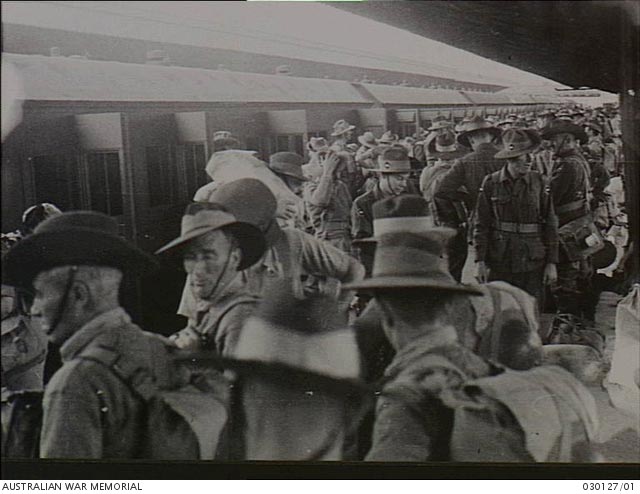 |
| "Adelaide, Australia. 14 March 1942. Troops of the 7th Australian Division, waiting to entrain at Adelaide after having disembarked from His Majesty's Transport (HMT) Orcades on their return from the Middle East." Australian War Memorial 030127/01. |
Units of the USAAF 5th Air Force transfer from Melbourne to Laverton, Australia. These include the 13th Reconnaissance Squadron (Heavy), 43d BG (Heavy), later redesignated as the 403rd Bomber Squadron. There are other transfers of units to and from Melbourne as General Brett rebalances his forces, and the air echelon of 88th Reconnaissance Squadron (Heavy), 7th BG (Heavy), ceases operating from Townsville, Australia with B-17's and begins moving to Karachi, India.
 |
| The New Yorker, 14 March 1942. |
The head of the British Military Mission to Chungking, Major-General Dennys, perishes in a plane accident near Kunming. Relations between Chiang Kai-Shek are not strained at the moment due to the lingering aftereffects of the Tulsa Incident.
US Government: U.S. President Franklin D. Roosevelt sent a proposal to all 48 state governors (Hawaii and Alaska are still territories) that speed limits throughout the nation be reduced to 40 miles per hour (64 km/h) to conserve tired due to the short supplies of rubber.
The War Production Board orders gasoline deliveries be cut 20 percent in 17 eastern states and the District of Columbia. This is due to the great loss of tankers in the past two months, particularly along the Eastern seaboard. Gasoline is already rationed.
 |
| "Adelaide, SA. 14 March 1942. Troops, hands extended, of the 7th Australian Division, receive a welcome from the people of the suburbs of Adelaide as they pass through a station on their way to Adelaide from the docks after having disembarked from His Majesty's Transport (HMT) Orcades on their return from the Middle East." Australian War Memorial 030127/02. |
We are, then, committed, heart and soul, to total warfare. How far, you may ask me, have we progressed along that road? I may answer you this way. Out of every ten men in Australia four are wholly engaged in war as members of the fighting forces or making the munition and equipment to fight with. The other six, besides feeding and clothing the whole ten and their families, have to produce the food and wool and metals which Britain needs for her very existence.Curtin is trying to bring as many Australian troops home from other theaters as possible to defend the homeland.
Norwegian Homefront: Seven Bishops of the Norwegian Lutheran Church resign their offices rather than co-operate with the Quisling government. They are Bishop Andreas Fleischer (Bergen), Bishop Wollert Krohn-Hansen (Tromso), Bishop Gabriel Skagestad (Stavanger), Bishop Hille (Hamar), Bishop Johan Storen (Nidaros, Trondheim), Bishop Berggrav (Oslo - Primate of the Norwegian Church), and Bishop Maroni (Agder Diocese).
Future History: Rita Tushingham is born in Liverpool, England. She becomes an actress after working as an assistant stage manager at the Liverpool Playhouse. Her film debut is in "A Taste of Honey" (1961), in which she participates with Paul Danquah in what is reputed to be the first interracial kiss in film history. Other prominent film roles include supporting roles in "Doctor Zhivago" (1965), "Being Julia" (2004), and "The Leather Boys" (1964). Rita has won a Golden Globe and BAFTA Award. Rita Tushingham remains a working actress as of this writing in 2020.
 |
| Early ''Li'l Abner'' Comic Strip From 14 March 1942 Featuring J. Sweetlips Garks aka Jeb S. Scragg -- Drawn & Signed by Al Capp. |
March 1942
March 1, 1942: Second Battle of Java Sea
March 2, 1942: Huge Allied Shipping Losses at Java
March 3, 1942: Japan Raids Western Australia
March 4, 1942: Second Raid On Hawaii
March 5, 1942: Japan Takes Batavia
March 6, 1942: Churchill Assaults Free Speech
March 7, 1942: British Defeat in Burma
March 8, 1942: Rangoon Falls to Japan
March 9, 1942: Japanese Conquest of Dutch East Indies
March 10, 1942:US Navy attacks Japanese Landings at Lae
March 11, 1942: Warren Buffett's First Stock Trade
March 12, 1942: Japan Takes Java
March 13, 1942: Soviets Attack In Crimea Again
March 14, 1942: The US Leans Toward Europe
March 15, 1942: Operation Raubtier Begins
March 16, 1942: General MacArthur Gets His Ride
March 17, 1942: MacArthur Arrives in Australia
March 18, 1942: Japan Attacks In Burma
March 19, 1942: Soviets Encircled on the Volkhov
March 20, 1942: "I Shall Return," Says MacArthur
March 21, 1942: Germans Attack Toward Demyansk
March 22, 1942: Second Battle of Sirte
March 23, 1942: Hitler's Insecurity Builds
March 24, 1942: Bataan Bombarded
March 25, 1942: Chinese Under Pressure in Burma
March 26, 1942: Win Or Die, Vows MacArthur
March 27, 1942: The Battle of Suusari
March 28, 1942: The St. Nazaire Commando Raid
March 29, 1942: The Free Republic of Nias
March 30, 1942: Japanese-Americans Off Bainbridge Island
March 31, 1942: Japanese Seize Christmas Island
2020






